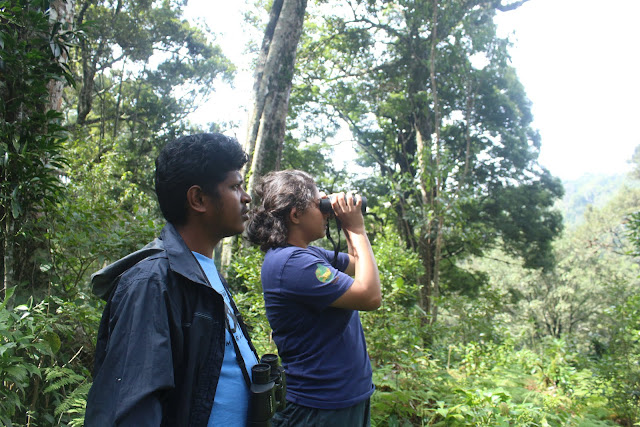Diurnal Primates and Nocturnal Aves
Prasanth P
December 23rd, 2019 a day to remember for sure as I got an opportunity to visit Nalumukh estate which is situated in the Pothigai hills, part of Western Ghats, along with Saravanan, Chiyan and Shivangi. The biodiversity of this area is just mind-blowing and the reason for the visit was in search of Nilgiri langur (Semnopithecus johnii) to help Shivangi in developing an art-based performance on the Nilgiri langur to bring awareness about the importance of nature. Nilgiri langur lives in troops and its diet comprises mainly of fruits and leaves. It is classified as vulnerable due to habitat destruction and poaching for its fur and flesh, it is also believed to have aphrodisiac properties.
 |
| Nilgiri langur (Semnopithecus johnii) |
We started from the ACCC field station at Manimutharu on our jeep at 7 am and made a stop in between to have breakfast. When we were having our breakfast we were entertained by some jungle babblers and minivets. Then we started our search and reached Manjolai and had tea. While having tea we heard the call of Nilgiri langur and finished the tea as soon as possible, got on to our jeep and started our pursuit. After travelling for 10 minutes we again heard a call and there they were amidst the branches far away but we couldn't have a good look at them and soon they moved away from us.
 |
| Lion-tailed macaque |
As we went up the hill it was an astonishing and unbelievable sight to see the rare endemic and endangered Lion-tailed macaque crossing the road, a troop of about 20, even though it was an amazing experience to see them as close as we did. It made me think about how the development of infrastructures in the forest and also the fragmentation of forest due to plantation has made this wonderful arboreal primate to come to the ground leaving the safety of the high branches to move from one place to another. While KMTR still has some fine intact wet evergreen forests, the plight of these macaques in other areas is simply pathetic. Then as the troop moved we started our travel and reached Nalumukh where we knew that a troop of Nilgiri langur had its territory behind the post office. And as said the troop was and very close too for us to get a very good look at them. As it was afternoon, the langurs were taking rest. We observed them for about an hour and then went to have lunch in a hotel nearby. After lunch, we were fortunate to have good weather which helped us to have a good look at another troop of langur little inside the forest at Nalumukh and along with that got some leech bites too. We also saw white-bellied treepie, oriental white-eye, a swarm of Apis dorsata commonly called "The Rock bee" the buzzing sound made by the bee swam was like an aeroplane taking off. They flew past us over the canopy in search of a better place to build their hive and we also saw a snake which we were not able to identify as it slithered away into the vegetation. After lunch we saw a total of three troops two near Nalumukh and one near Oothu estate observing their feeding, playing and grooming behaviours was a good experience. As the sun started moving down we too started our journey down the hill and after a little tiring ride, we reached the Manimutharu falls by 6 pm.
 |
| The Rock bee |
As we reached the plains Chiyan suddenly applied the brake and the tiers made a lot of noise when we asked him why? he told us to look at the road and there they were the nocturnal Aves sitting on the road. What do you think? Who were there fellows? Some people think that owls are only the nocturnal birds moving around but there are also other nocturnal birds. The nocturnal aves on the road were nightjars these birds are medium-sized with a short bill and are insectivore. During the night time, they are seen sitting in open spaces and no one is sure of the reasons. Some say that they perch on the roads for warmth others say that they come to open spaces to hunt insect. We got the chance to look at two species of nightjars Jerdon's nightjar (Caprimulgus atripennis) and Indian nightjar (Caprimulgus asiaticus) both are endemic to India. Finally, we reached ACCC at about 7 pm with a lot of memories and stories to share and to feel happy about it.
 |
| Indian nightjar (Caprimulgus asiaticus) |
 |
| Jerdon's nightjar (Caprimulgus atripennis) |








Amazing trip man. See more creatures. Best of Luck.
ReplyDelete